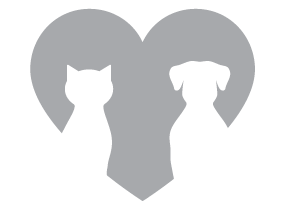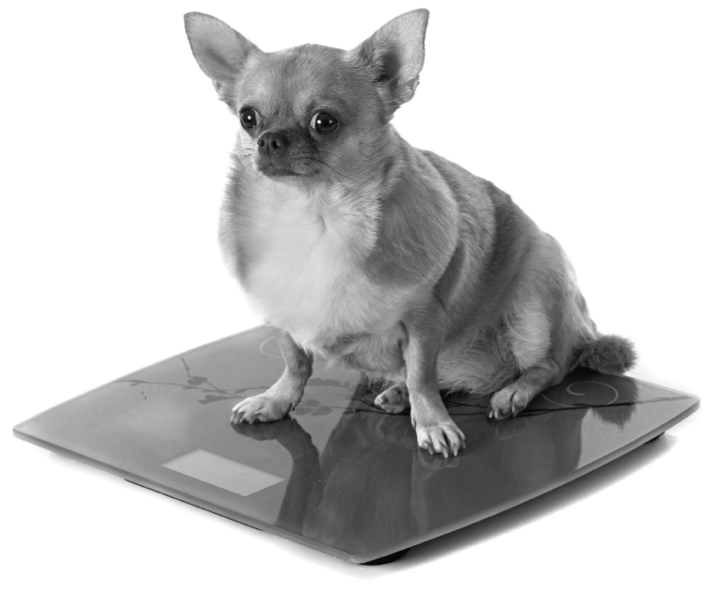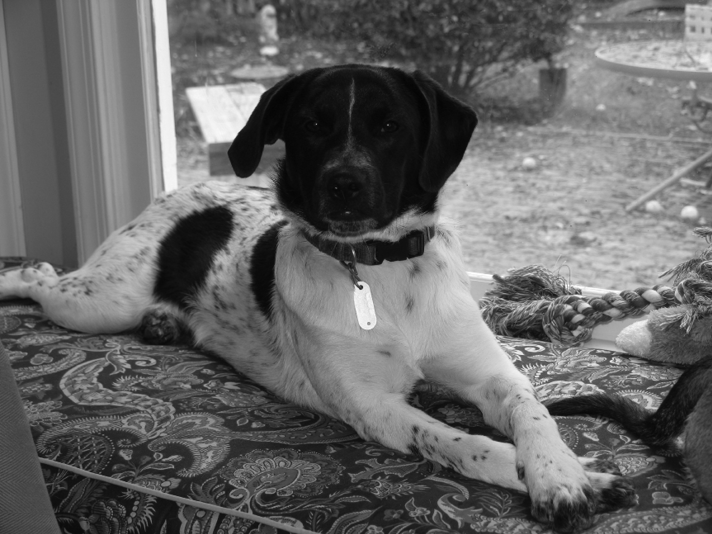
Chapter Six:
Recognizing Obesity and
Avoiding an Overweight Dog

We saw earlier that the APOP reports that more than 52 percent of dogs are either overweight or obese (http://petobesityprevention.org). The potential risks of being an overweight dog is similar to that of humans; this includes diabetes, high blood pressure, heart and respiratory disease, ligament injury, kidney disease, and a decrease in life expectancy. In order to keep your canine healthy and happy, it is best to keep them fit and at a healthy weight.
Let’s take a look at what causes obesity and how we can avoid it.
Contributing Factors to Obesity in Dogs
The causes of obesity in dogs can be more than just overeating. When energy intake exceeds the dog’s daily requirements, they begin to store food as fat. This means that a dog that does not get much exercise could still gain weight without the appearance of overeating. Even if you control how much your dog eats, if his exercise level significantly decreases, he can gain weight without increasing his food intake.
The key to avoiding an overweight or obese dog is two-fold: do not overfeed your dog and make sure your canine gets a lot of exercise. Here are some specific reasons could explain your dog’s weight gain.
High availability of food
While some dogs will eat only what they need, others will consume everything in their bowl and their friend’s bowl if given the opportunity. Overfeeding of treats and table scraps can also cause dogs to pack on the pounds.
Low activity levels
A dog that does not get outside to run and play often will burn less calories than his more active friends. If you think your dog is a bit heavy, a diet will help, but adding in playtime and opportunities for exercise will make a big difference.
Getting fixed
This procedure can lower your pet’s metabolic rate. Sex hormones will decrease which has an impact on general physical activity and appetite. Doctors Foster and Smith from the website http://peteducation.com report, “It is true that neutered and spayed animals burn fewer calories than intact pets, so we generally need to feed them less.”
Genetics
Some breeds are predisposed to becoming overweight and their owners must be more diligent in their feeding and/or activity levels than other breeds. These include Labrador Retrievers, Dachshunds, Beagles, Cairn Terriers, Cocker Spaniels, Collies, Shetland Sheepdogs (Shelties) and Basset Hounds (http://peteducation.com).
Age
According to Doctors Foster & Smith’s article, “Diseases & Conditions Contributing to Dog Obesity,” dogs tend to put on weight between ages two and twelve (particularly around age six). Therefore, this is an important age to make sure you monitor how much food your dog is in-taking compared to how much exercise she is getting. If you can maintain a healthy balance during this time, the chances of your dog becoming obese decreases as she becomes a “senior.”
On their website, the doctors recommend keeping an eye on weight when your dog is young because an overweight dog under the age of two is more likely to remain obese throughout his entire life. They argue that establishing healthy eating habits and controlling weight early can lead to healthy weight for a dog’s entire life (http://peteducation.com).
Medication
Some medicines can influence metabolism and appetite, including glucocorticoids, barbiturates and benzodiazepines. When medicines used to treat other ailments (such as epilepsy) negatively impact a dog’s metabolism, your pet is likely to add some pounds.
Illnesses
Various diseases can cause dogs to gain weight by impacting their adrenal gland, pancreas/insulin and pituitary glands. These include hypothyroidism, Cushing disease, insulinoma, diabetes and pituitary gland/brain diseases.
If you notice that your dog has any of these contributing factors, you should consult his veterinarian on how to adjust his diet and/or activity level to ensure obesity does not occur.

Recognizing if Your Dog is Overweight
Trying to visually assess whether or not your dog is overweight would be a lot like trying to guess a person’s weight just by looking at them. While it might be easy to spot a truly obese person, it would not be as easy to tell if a tall man or woman was carrying more weight than they should. In much the same way, a large dog could be overweight even though he doesn’t look it. You should consult your dog’s doctor on his proper weight for his age and frame.
Even if you only see your dog’s veterinarian for annual visits, he should still be able to provide you with some insight on your dog’s weight and what the goal weight should be. Though imperfect (because weight goals change with age and gender), a weight guideline by breed is listed below (courtesy of http://petobesityprevention.org):
Ideal Weights of Dog Breeds
|
Afghan Hounds |
58 to 65 pounds |
|
Airedale Terriers |
40 to 65 pounds |
|
Akitas |
75 to 115 pounds |
|
Alaskan Malamutes |
70 to 95 pounds |
|
American Staffordshire Terriers |
55 to 65 pounds |
|
Australian Cattle Dogs |
30 to 35 pounds |
|
Australian Shepherds |
40 to 65 pounds |
|
Basenjis |
20 to 25 pounds |
|
Basset Hounds |
45 to 65 pounds |
|
Beagles |
18 to 30 pounds |
|
Belgian Malinois |
55 to 75 pounds |
|
Bernese Mountain Dogs |
85 to 110 pounds |
|
Bichon Frises |
7 to 12 pounds |
|
Bloodhounds |
80 to 110 pounds |
|
Border Collies |
27 to 45 pounds |
|
Border Terriers |
11 to 15 pounds |
|
Borzois |
60 to 100 pounds |
|
Boston Terriers |
10 to 25 pounds |
|
Bouviers des Flandres |
95 to 120 pounds |
|
Boxers |
50 to 75 pounds |
|
Brittany Spaniels |
30 to 40 pounds |
|
Brussels Griffons |
6 to 12 pounds |
|
Bull Terriers |
Miniature: 24 to 32 pounds Standard: 45 to 80 pounds |
|
Bulldogs |
40 to 50 pounds |
|
Bullmastiffs |
100 to 300 pounds |
|
Cairn Terriers |
13 to 18 pounds |
|
Cardigan Welsh Corgis |
25 to 30 pounds |
|
Cavalier King Charles Spaniels |
10 to 18 pounds |
|
Chesepeake Bay Retrivers |
55 to 80 pounds |
|
Chihuahuas |
4 to 6 pounds |
|
Chinese Crested |
Less than 10 pounds |
|
Chinese Shar-Pei |
45 to 60 pounds |
|
Chow Chow |
45 to 70 pounds |
|
Cocker Spaniels |
23 to 28 pounds |
|
Collies |
50 to 70 pounds |
|
Dachshunds |
Mini: 8 to 10 pounds Standard: 10 to 12 pounds |
|
Dalmatians |
50 to 55 pounds |
|
Doberman Pinschers |
65 to 90 pounds |
|
English Cocker Spaniels |
26 to 34 pounds |
|
English Setters |
45 to 80 pounds |
|
English Springer Spaniels |
40 to 50 pounds |
|
Flat-Coated Retrievers |
60 to 70 pounds |
|
French Bulldogs |
19 to 28 pounds |
|
German Shepherds |
75 to 95 pounds |
|
German Shorthaired Pointers |
45 to 70 pounds |
|
German Wirehaired Pointers |
60 to 70 pounds |
|
Giant Schnauzers |
55 to 80 pounds |
|
Golden Retrievers |
65 to 75 pounds |
|
Gordon Setters |
45 to 80 pounds |
|
Great Danes |
110 to 180 pounds |
|
Great Pyrenees |
85 to 100 pounds |
|
Greater Swiss Mountain Dogs |
130 to 135 pounds |
|
Greyhounds |
6 to 10 pounds |
|
Havanese |
7 to 12 pounds |
|
Irish Setters |
55 to 75 pounds |
|
Irish Wolfhounds |
90 to 150 pounds |
|
Japanese Chin |
4 to 15 pounds |
|
Jack Russell Terriers |
14 to 18 pounds |
|
Keeshond |
35 to 45 pounds; 55 to 65 pounds |
|
Labrador Retrievers |
65 to 80 pounds |
|
Lhasa Apsos |
13 to 15 pounds |
|
Maltese |
4 to 6 pounds |
|
Mastiffs |
150 to 160 pounds |
|
Miniature Pinschers |
8 to 10 pounds |
|
Miniature Schnauzers |
12 to 15 pounds |
|
Newfoundlands |
100 to 150 pounds |
|
Norwegian Elkhounds |
40 to 60 pounds |
|
Norwich Terriers |
10 to 12 pounds |
|
Nova Scotia Duck Trolling Retrievers |
37 to 50 pounds |
|
Old English Sheepdogs |
60 to 100 pounds |
|
Papillons |
7 to 10 pounds |
|
Pekingese |
Mini: 6 to 8 pounds Standard 8 to 10 pounds |
|
Pembroke Welsh Corgi |
23 to 27 pounds |
|
Pomeranians |
4 to 7 pounds |
|
Poodles |
Mini: 11 to 17 pounds Standard: 45 to 65 pounds |
|
Portuguese Water Dog |
35 to 55 pounds |
|
Pugs |
13 to 18 pounds |
|
Rhodesian Ridgebacks |
65 to 90 pounds |
|
Rottweiler |
70 to 135 pounds |
|
Saint Bernard |
110 to 200 pounds |
|
Samoyeds |
35 to 65 pounds |
|
Schipperkes |
12 to 18 pounds |
|
Scottish Terriers |
18 to 21 pounds |
|
Shetland Sheepdogs |
18 to 20 pounds |
|
Shiba Inu |
15 to 25 pounds |
|
Shih Tzu |
8 to 16 pounds |
|
Siberian Husky |
35 to 60 pounds |
|
Silky Terriers |
8 to 11 pounds |
|
Soft-Coated Wheaten Terriers |
30 to 45 pounds |
|
Staffordshire Bull Terriers |
23 to 38 pounds |
|
Standard Schnauzers |
30 to 45 pounds |
|
Tibetan Terriers |
18 to 30 pounds |
|
Toy Fox Terriers |
4 to 7 pounds |
|
Vizla |
45 to 60 pounds |
|
Weimaraners |
50 to 70 pounds |
|
Welch Terriers |
20 to 21 pounds |
|
West Highland White Terrier |
13 to 21 pounds |
|
Whippets |
25 to 45 pounds |
|
Wirehaired Fox Terrier |
13 to 20 pounds |
|
Yorkshire Terriers |
6 to 7 pounds |
In addition to the guide above, you can also assess your dog visibly. According to “The Everything Dog Health Book” by Kim Campbell Thornton and Debra Eldredge, DVM, when you look at your dog, you should be able to see a defined waistline behind his ribs. If you see a solid chunk of flesh, your dog could be overweight. If your dog huffs and puffs at the slightest level of exertion, they advise that you put him on a diet and exercise plan (Thornton 2005).
NOTE: If your dog actually falls below the standard weight for his breed or size, you should consult your veterinarian for potential causes. While we hope the solution is simply to increase his caloric intake, low weight in dogs can point to other health issues or concerns. If your dog is significantly underweight or has lost significant weight in a short period of time, additional testing might be necessary to determine cause and a treatment approach.
Addressing Weight Loss for Your Dog
Achieving a healthy weight for your dog is much like achieving one for yourself. If you need to lose weight, you should consume fewer calories than you burn each day; whereas if you need to gain weight, you should take in more calories than you burn. As you work with your dog to achieve a healthier energy output versus caloric intake, the first thing you should do is consult your veterinarian to determine a plan that is ideal for your pet.
If you believe your dog is a little too heavy and want to take some small measures yourself, you can start with feeding your dog a little less on one of the feeding strategies mentioned in the previous chapter. The solution might be as simple as measuring an exact amount of food at designated feeding times instead of leaving a bowl of food out all day.
Alternatively, you can switch to a lower-calorie dog food, but dog food labeled “lite” can mean several different things. It is important to carefully read the calorie guide on your dog food and talk to your veterinarian about how many calories your pet needs given his age, activity level, physical condition, and overall heath (Thornton 2005).
Why Weight Matters
I understand how tempting it is to look at your overweight dog and think that they look fine and do not need to change their eating habits. You might even think that a dog with some extra meat on his bones is a happy dog. After all, is that not what is meant by the phrase “a dog’s life?” The problem comes from the fact a spoiled, pampered life is not necessarily the healthiest life for a dog.

In truth, low levels of activity are not any healthier for your dog than it is for you. People who live more of a sedentary lifestyle tend to gain weight — weight that eventually puts too much strain on their joints and causes a wide-range of health issues. That is why people who do not get much physical activity in their work life will spend time in the gym to stay fit.
Since obesity in your beloved canine friend will cause the same kind of health concerns you face if he enjoys a little too much of “a dog’s life,” you should strive to get him the kind of physical activity you would get by going to the gym. I am not saying you need to engage your dog in “hard labor,” but you should make sure the amount of energy he expends each day is equal to or lower than his caloric intake.
Remember that on top of all the other health issues obesity causes in dogs, a decrease in life expectancy is paramount among them. In general, smaller dogs live longer than larger breeds, but all dogs owners can expect their pet to live between eight years (for large breeds) and 11 years (for petite breeds) (Coates 2015). In the grand scheme of things, that really is not all that long. You owe it to yourself and your pet to ensure weight issues do not shorten his life needlessly.
